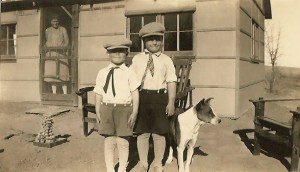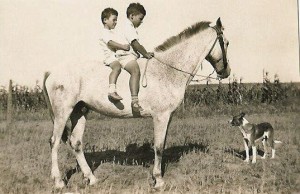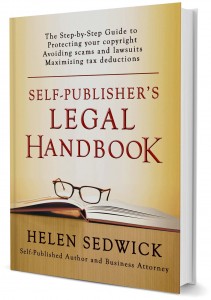Last week, I had lunch with a writer who is deep into revising her memoir. She showed me a stack of photos from her years in summer stock theater and Off-Off-Broadway plays. She told me how important they were to her book. Unfortunately, I put my lawyer hat on, and I asked her if she had permission to use the photos. Most likely a photographer or theater company or someone owns the copyright in those photos. Her jaw dropped. “How am I ever going to figure that out?”
Very good question.
When the ownership of a copyrighted work is unknown, or the owner cannot be found, we have what is called an orphan work. Memoir and non-fiction writers run into this problem all the time.
Orphan works include everything from World War II photographs to anonymous internet postings. Tens of millions of orphan works are hidden in libraries, museums, historical societies, not to mention attics. Many, such as films by long-defunct production companies, are disintegrating because no one has an economic incentive to preserve materials that cannot be displayed without risking copyright infringement. In fact, some experts estimate that 90% of all copyrighted work is orphan work.
The problem is getting worse. Many copyright laws no longer require registration and notices, making rights holders harder to find. Repeated extensions of the copyright term gave rights to creators who were already long gone. To make matters worse, the mass digitization of library and museum collections have made millions of orphan works discoverable by anyone with an internet connection.
Does a writer risk and publish the materials without permission or must this valuable, informative “orphan work” remain tucked away and inaccessible to the public?
Before we answer that question, remember that any photograph, writing or other work in the public domain is not an orphan work because it is no longer protected by copyright. For more details take a look at Cornell University’s Copyright Expiration Chart. Public domain works include:
- Any work first published before 1923
- Any unpublished work created before 1895.
- Any unpublished work created by someone who died before 1945.
Check out the Chart for more scenarios.
US Copyright Office Proposes a Solution
For years, U.S. and foreign legislatures have tried to find solutions to the copyright issues of orphan works and mass digitization. The challenge is balancing the interests of copyright owners in protecting their rights with the interest of the public in having access to its creative, historical and cultural heritage. On June 4, 2015, the U.S. Copyright Office weighed in.
The long-awaited Report of Orphan Works and Mass Digitization is an exhaustive, 234-page survey of history, opinions, and approaches and an interesting read for anyone who wants to know how Hungary, Canada, and the UK are dealing with these issues. At its core, it recommends amending the US Copyright Act, a law in sore need of updating on many fronts.
The Report lays out the general framework for amending the Copyright Act to limit the liability of users who can demonstrate that they engaged in good faith and diligent searches for the copyright owners. The key points are:
- It would apply to all categories of copyrighted orphan works (text, images, recordings), whether published or unpublished, new or old (but not in the public domain).
- The limitation on liability would be available to all users and uses, whether commercial or non-commercial, other than fixations of visual works on commercial, useful items, such as mugs and t-shirts.
- Users must be able to prove to a court by a preponderance of the evidence that they performed a good faith, diligent search to identify and locate the owner of the work BEFORE they used it. The Copyright office would publish Recommended Research Practices from time to time to provide guidance on what is to be considered an adequate search.
- Users must file a Notice of Use with the Copyright Office. Notices would create a searchable database for copyright holders to police their work.
- Users must provide attribution to the legal owner. if known.
- Users must include an “orphan works” symbol with any public distribution, display or performance.
- If the rights holder steps forward, the user would be obligated to pay the rights holder “reasonable compensation,” namely the amount a license would have reasonably cost. In theory, the cost of a license is expected to be much less than monetary damages in an infringement case.
- Certain users, such as museums, libraries, and public broadcasters would not be liable for monetary damages provided they cease infringing uses upon demand by the copyright holder.
Response to the proposal has been mixed. The Association of Research Libraries calls it burdensome and unworkable, particularly for dealing with mass digitization. Others say the proposed legislation does not provide enough legal certainty. As any lawyer will tell you, legal certainty is unattainable and frankly inappropriate where the law is trying to balance legitimate but opposing interests.
My thoughts are more favorable. The proposed orphan works legislation could provide a workable approach for independent authors, publishers, bloggers, and film makers wanting to use long-forgotten works. It would permit the use of millions of unique and insightful creations for the benefit and enjoyment of everyone.
A win-win in my view.
What You Can Do
If you want to weigh in, there will be plenty of opportunities. Considering the controversy, I expect more court cases, public hearings, reports, and requests for public comments. If you want to be heard, watch the process of the legislation for future opportunities to participate or join one of the active organizations.
In the meantime, if you have an image or other work and you cannot figure out who owns the copyright, conduct a diligent search and keep records of that search. If you still can’t figure out ownership, then you have to decide whether to take a chance that someone will step forward and claim ownership.
And consider whether the image or work is in the public domain. Public domain works include:
- Any work first published before 1923
- Any unpublished work created before 1895.
- Any unpublished work created by someone who died before 1945.
In the case of my friend, she’s taking a closer look at the photos to decide which are worth the risk and which are not. A good exercise for every writer in this situation.
SHARE THIS







This is an excellent summary of the subject. It’s one that Photo Organizers have been grappling with as we digitize family photo collections. We want to preserve family memories, and make archival backup of photos, but still respect the rights of the photographer. Often they cannot be identified or located to ask permission. It’s frustrating at times, but we do the best we can. I’m glad to see that my business practices are basically in line with your recommendations and the proposed amendments to the Copyright Act.
Where can I find an orphan works symbol?
Abigail, As far as I know, there is no symbol. But I think there should be one.
Good to know. Do you know where I might find a Notice of Use form to file with the Copyright Office? Have been unsuccessful in finding one anywhere so far.
It’s form M-269. Link is in the lower right hand corner of this page: https://www.copyright.gov/forms/
Hello,
I would like to use personal letters written by various people – some individuals’ identities I cannot track down while some I can, purchased by me at an auction, in a book. People who wrote these letters passed away, and 70 years have lapsed after their death. Many of the letters were written in the late 1800s. Are these letters in Public Domain? Am I allowed to use them in my book? If I was able to id the authors – it’s 70 years after their death, is this accurate? For the Orphaned Works – is it 120 years starting the count with the year the letters were written?
Thank you!
From what you say, these letters sound like they are in the public domain. But also look at the copyright notice of the book that contains the letters. If the book is still subject to copyright, then don’t use any content that was created for that book such as a introduction or commentary.